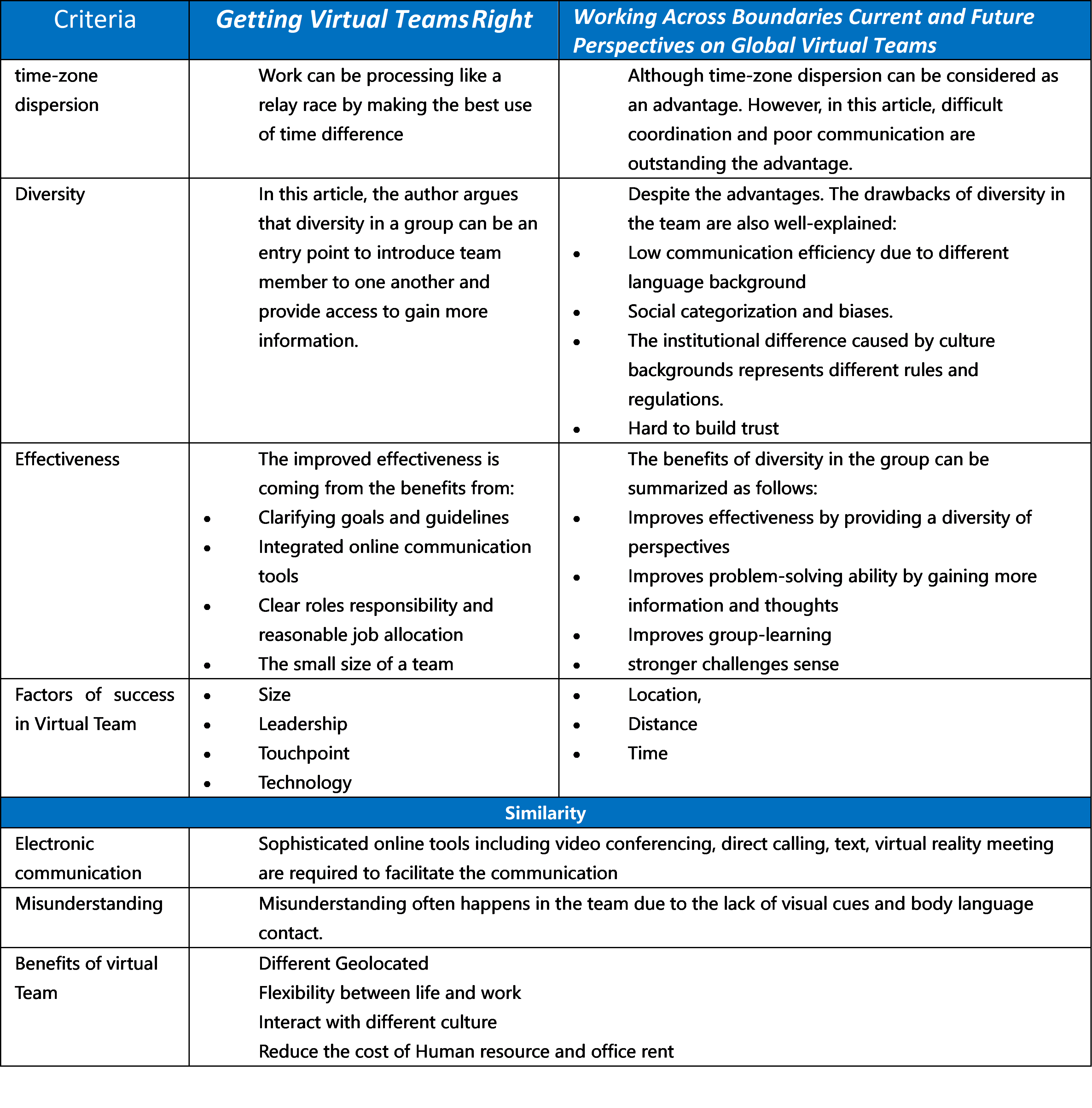Table of Contents (Click to show/hide)









Executive Summary
Teams were gathered together across geographical, regional, national, culture, language, and time is the phenomenon known as virtual teams. Ferraxxi (2014) and Jimenez (2017) ’s research demonstrate the opportunities and challenges. This report evaluates their opinion and introduces their fundamental differences. Virtual team can be a sharp sword tackling problems and tasks effectively or a liability if the internal affair is not appropriately handled. According to research, a Key Performance Indicators (KPIs) setting will be helpful for team training, hence improves essential skills, personal goal benefits personal growth and priority management is necessary to improve the effectiveness in the team. Those are recommended for building a better virtual team.
Introduction
Business owners and companies are always looking for an innovative way to minimize costs and maximize productivity. With the rapid development of technology, people nowadays are more likely to utilize the resources at hand to accelerate efficiency at work. However, “Virtual Team” has become a trendy mean of team establishment as it is a group of different geographically-located people working independently to pursue a shared goal. Ferraxxi (2014) and Jimenez (2017) illustrate their research and opinions on virtual team building in “Getting Virtual Teams Right” and “Working Across Boundaries Current and Future Perspectives on Global Virtual Teams”. With its appealing advantages and inevitable challenges, this report will critically review based on their key arguments and prompt research. Flexibility and team diversity are considered the most significant advantages of this particular working method. However, on the other hand, internal confliction, time-zone dispersion and communication are the primary concerns. Differences between those two articles will be listed. Furthermore, recommendations will be presented below.
2.0 Key Arguments of the Authors
2.1 Getting Virtual Teams Right
Online team is facing a high failing rate nowadays. According to Ferraxxi (2014), a significantly high failure rate of 66% was found by the outsourced IT projects study of Deloitte. The challenges can be summarized as following: (a) fail to meet client’s requirements; (b) inefficient and misinterpreted communication (c) Confusing task-organize technology
In terms of solutions, Ferraxxi brought up some ideas to tackle the mentioned problems. Roles and scale are crucial at the beginning: divide team size-wise and allocate work accordingly. In his opinion(2014), team members will be less active with the growth of the scale due to the “social loafing” and interminable communication. Distribute work blindly regardless of the roles and specialties will lead to disarray and instability。
A right leadership and a shared goal are excellent in fostering team growth. Exchange background story and feel would be helpful to establish trust. He argues (2014), trust is a mutual feeling, and it starts with respect and empathy. Relationship building within a group should be an ongoing process: Introducing new team member, pairing novice with a mentor, constant motivation from leaders and regular face to face meeting are required. Honesty is the best policy, Ferraxxi thinks being honest and modelling “caring criticism” among team members are the foundation of successful teamwork. Last but not least, he suggests platform which includes conference calling, text messaging and gathering discussion should be offered in order to build more efficient communication and avoid unnecessary work.
2.2 Working Across Boundaries: Current and Future Perspectives on Global Virtual Teams
The virtual team shows up many opportunities and potential advantages. Tasks can be accomplished like a relay race by utilizing the time difference. Multicultural background can create effectiveness and improve performance through homogeneously gaining access to kinds of cognitive resources and knowledge. In the article, knowledge-base view (KVB) by Cannella (2018) has been introduced to explain that group learning can be stimulated by diversity and e - technology should be well-utilized to facilitate team communication.
In the article, time-zone dispersion, Multiculturalism communication, team relationship building and bias are the biggest concerns. Time-zone dispersion is considered as the most prominent issue. Also, under-performance behaviour is easily detected in a multicultural team due to the following reasons:
· unconsolidated work language,
· communication insufficiency
· inefficiency
What’s more, the extra external message exchange is missing due to the lack of physical contact and face-to-face communication. This will ultimately lead to an untrusted and bias work relationship among team members. (Jimenez, 2017)
3.0 Differences in the Arguments

4.0 Recommendations
4.1 Team Performance Evaluation
According to IsaacMustapha (2017), A team leader should be well aware of the strength and weakness of each team member and reasonable key performance indicator (KPI) should be well set up as a guideline and motivation. Isaac stresses that leader should provide decent support which includes instruction on the task matters and necessary tools that needed. In addition to modelling and coaching behaviours, organizational practices were included because organizational resources, constraints, and training factors may affect one’s judgment.
4.2 Training
Proper training should be provided team member in order to make sure the smooth workflow. According to the study of Staples & Webster (2007), training is considered as one of the best practices for improving the effectiveness and helpful in building a positive relationship among team members at an organizational level. The training should include technical skills,customer service, remote coordination skills and electronic communication skills.
4.3 Personal Goal
Share goals and KPIs that align with the team objectives is a key to unite the teamwork. A personal goal that aligns with the team objective is also vital to personal growth and relationship building. Personal cognitive factors are related to the behaviours, and it is a judgement to a person’s skill in practising a designated pattern task (Staples & Webster, 2007). Also, there is always a low-confidence in personal contribution. This low perceived instrumentality is one of the reasons for team motivation loss (Hertel, Konradt & Orlikowski, 2004). So, helping team members to set up personal achievement goals and pushing them to realize those will be beneficial to team building and effectiveness.
4.4 Priority Management
Online team is facing a high failing rate nowadays (Kirkman, Rose, Tesluk & Gibson, 2004). It is a hassle to coordinate all the team members across the different time zone into one meeting due to the significant time difference (Mustapha, 2017). Research has identified behaviours such as planning, strategizing, and prioritizing as those that help a team become ready to perform their task(s) and as such are essential to the effectiveness of interdependent teams (Maynard, Mathieu, Rapp, & Gilson, 2012). Team members should understand the priority structure of each task to coordinate and carry out their work.
5.0 Conclusion
With the information presented above, the details opinions in these two articles regarding the virtual team are different, but the overall perspectives are similar. Virtual team has no doubt is a trendy work model with its flexibility, diversity and low-cost. However, the drawbacks like internal confliction, time-zone dispersion and communication are challenging the effeteness in the team. By identifying the problems and engaging the resources, prioritizing each task, structuralize personal and team goals and ensure the proper training demonstrate positive performance in
improving virtual team effectiveness and success rate along the way.
What do you think about virtual team? Do you think it is an appropriate working method that should be applied in every business module?
Reference List
- Kirkman, B. L., Rosen, B., Tesluk, P. E., & Gibson, C. B. (2004). The impact of team empowerment on virtual team performance: The moderating role of face-to-face interaction. Academy of Management Journal, 47(2), 175-192.
- IsaacMustapha, M. (2017). Identifying Factors That Impact Virtual Teams. Archives of Business Research, 5(2).
- Jimenez, A., Boehe, D. M., Taras, V., & Caprar, D. V. (2017). Working across boundaries: Current and future perspectives on global virtual teams. Journal of International Management, 23(4), 341-349.
- Staples, D. S., & Webster, J. (2007). Exploring Traditional and Virtual Team Members’“Best Practices” A Social Cognitive Theory Perspective. Small group research, 38(1), 60-97.
- Hertel, G., Konradt, U., & Orlikowski, B. (2004). Managing distance by interdependence: Goal setting, task interdependence, and team-based rewards in virtual teams. European Journal of work and organizational psychology, 13(1), 1-28.
- Maynard, M. T., Mathieu, J. E., Rapp, T. L., & Gilson, L. L. (2012). Something (s) old and something (s) new: Modeling drivers of global virtual team effectiveness. Journal of Organizational Behavior, 33(3), 342-365.









